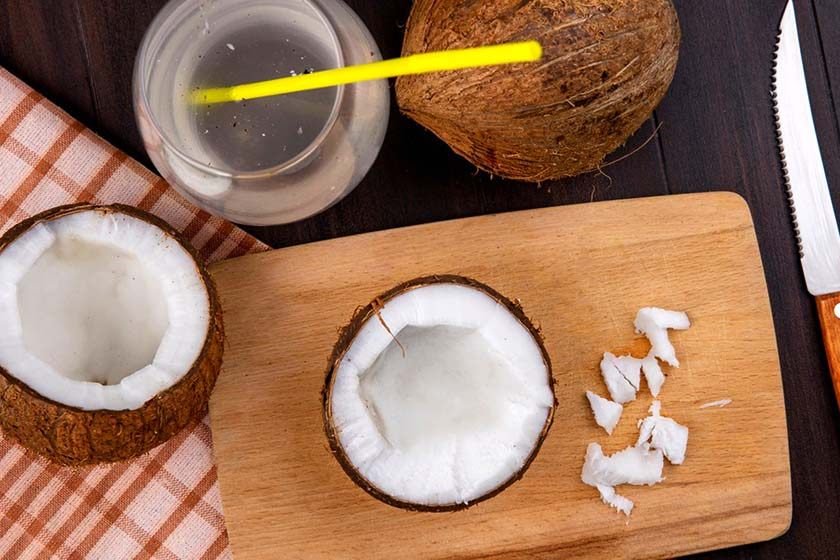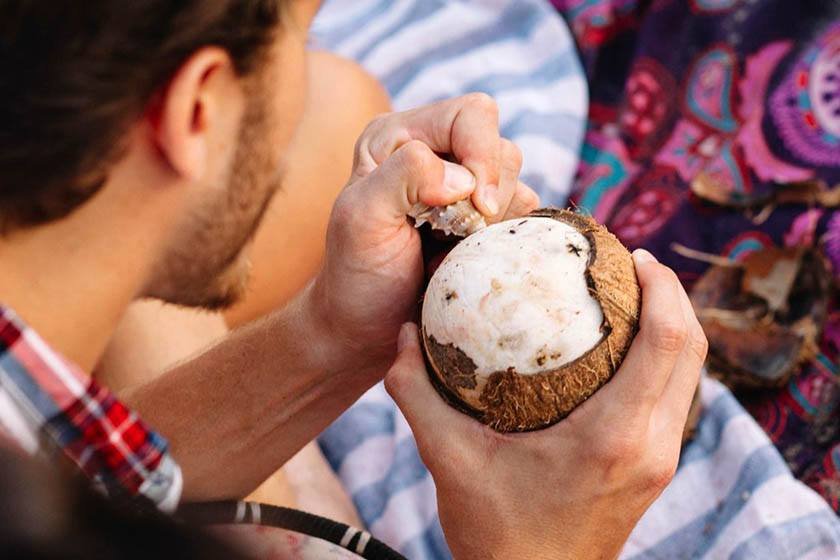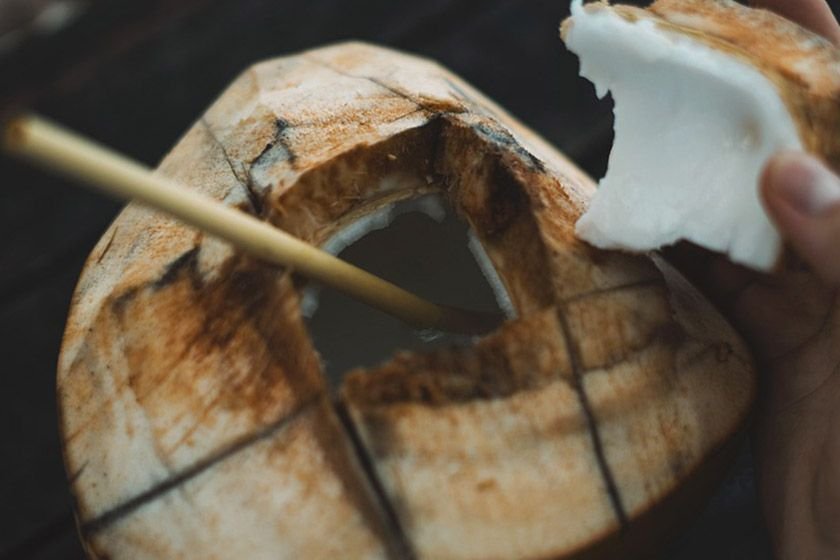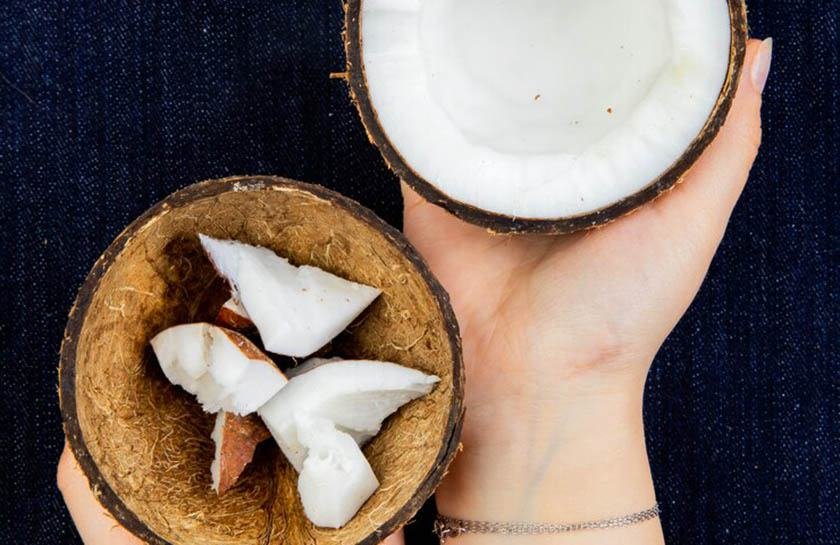Opening a coconut may initially appear challenging – however, with the appropriate tools and techniques, it can be a straightforward and rewarding endeavor.
This guide examines the reasons for opening a coconut, outlines the essential tools required, and presents several effective methods for doing so safely.
It provides a comprehensive step-by-step process and offers tips to prevent any potential mishaps. Additionally, readers will discover the best way to open a coconut and learn about the notable health benefits associated with this tropical fruit.
Prepare to appreciate the delightful flavor of fresh coconut.
Why Open a Coconut?
Opening a coconut is a fundamental skill for those interested in exploring the diverse realm of tropical fruits. This process not only grants access to refreshing coconut water, an excellent source of hydration, but also yields nutrient-rich coconut meat, which can be utilized in a variety of exotic recipes.
Mastering the safest and most effective method for opening a coconut not only improves culinary techniques but also enables individuals to fully appreciate the health benefits of this versatile fruit.
Whether for hydration, culinary applications, or DIY projects, the ability to efficiently open a coconut is an invaluable asset for enhancing food enjoyment and preservation.
What Tools Do You Need to Open a Coconut?
To efficiently and safely open a coconut, it is imperative to select the appropriate tools. Essential kitchen equipment may include:
- a manual or electric coconut opener;
- a sharp knife for precise slicing;
- a hammer or cleaver for cracking the shell;
- a sturdy cutting board to provide leverage and grip strength.
Each of these tools is critical in ensuring that the process of opening a coconut is both effective and safe, whether one is preparing coconut water or coconut meat for various tropical recipes.
Hammer and Screwdriver Method
The hammer and screwdriver method is a straightforward and effective technique for opening a coconut, particularly when specialized coconut-opening tools are unavailable. This method involves using a screwdriver to create a hole in one of the coconut’s eyes, allowing for the drainage of coconut water before employing light strikes with a hammer to crack the shell.
This approach ensures minimal effort while preserving the integrity of the coconut meat for later culinary use. To begin, gather the necessary materials: a sturdy screwdriver, a hammer, and a clean cloth to manage any potential spills.
It is essential to securely hold the coconut in one hand to provide stability during the cracking process. Focus on striking the screwdriver gently at an angle to minimize the risk of slipping.
After creating the hole, rotate the coconut to allow the water to flow into a bowl. This step not only prevents a mess but also preserves the refreshing coconut water for use in smoothies or cocktails.
Once the coconut is drained, the best way to open a coconut is to apply controlled, firm taps with a hammer along the equator of the shell.. Gradually increase the force as necessary, always prioritizing safety by keeping fingers clear of the striking area.
Meat Cleaver Method
Utilizing a meat cleaver to open a coconut is an effective technique, particularly for individuals who are adept at handling sharp tools in the kitchen. This method entails carefully slicing the coconut in half with the cleaver, ensuring that control is maintained for safe cutting.
While this technique may require a degree of grip strength, it provides a swift means to access both the refreshing coconut water and the nutrient-rich coconut meat for various culinary purposes.
To commence, it is advisable to select a stable surface that will not slip during the process, such as a sturdy cutting board. Secure the coconut in position and identify the ‘eyes’ or softer spots where the cleaver can penetrate more easily.
Before initiating the first cut, it is crucial to hold the coconut firmly with one hand while keeping fingers clear of the blade’s path. As downward force is applied with the meat cleaver, one should remain vigilant of the surroundings to prevent any accidents.
Incorporating these safety measures can enhance one’s cutting technique, transforming the task into a straightforward and enjoyable experience.
Drill Method
The drill method presents a contemporary approach to opening a coconut, particularly advantageous for individuals who prefer utilizing power tools in the kitchen. By meticulously drilling a hole into one of the coconut’s eyes, one can efficiently drain the water.
Subsequently, a hammer may be employed to crack the shell with precision, ensuring a clean break that preserves the coconut meat for future use in refreshing beverages or tropical recipes.
To optimize the efficacy of this technique, it is imperative to select an appropriate drill bit, ideally a standard size that fits comfortably into the coconut’s eye. Employing a power drill facilitates swift penetration into the hard shell, thereby conserving both time and effort.
Additionally, utilizing a sturdy surface to securely hold the coconut during the process can significantly enhance safety and stability. Once the water has been drained, it is advisable to use a mallet rather than a standard hammer to achieve a more controlled strike, further improving precision in breaking the shell.
This combination of tools and techniques ensures a successful fruit preparation experience, yielding both coconut water and tender meat, ready for various culinary applications.
Kitchen Knife Method
 The kitchen knife method is one of the most accessible and straightforward techniques for opening a coconut. By selecting a sharp kitchen knife, an individual can carefully slice along the equator of the coconut shell, enabling an easy separation of the two halves.
The kitchen knife method is one of the most accessible and straightforward techniques for opening a coconut. By selecting a sharp kitchen knife, an individual can carefully slice along the equator of the coconut shell, enabling an easy separation of the two halves.
This method not only provides direct access to the coconut water but also facilitates the extraction of the coconut meat, rendering it ideal for various culinary applications.
To execute this method safely, it is essential to stabilize the coconut on a cutting board. One should hold the coconut firmly with one hand while guiding the knife with the other, ensuring that fingers are kept away from the blade’s path.
When slicing, it is important to apply even pressure to achieve a smooth cut, and if necessary, rotate the coconut to avoid any awkward angles. Once the shell has been successfully divided, a spoon or a dedicated tool can be used to scoop out the fresh coconut meat, which may be enjoyed as a snack or incorporated into recipes.
The best way to open a coconut effectively requires patience and precision, especially when mastering the kitchen knife method.
What Are the Steps to Open a Coconut?
Opening a coconut requires several methodical steps to ensure both safety and efficiency when extracting the refreshing coconut water and nutrient-rich coconut meat.
It is advisable to begin by selecting a stable cutting board and the appropriate tools, as proper preparation is crucial for a clean and secure process. Adhering to these essential steps will allow individuals to fully appreciate the flavors and hydration benefits provided by fresh coconut.
Drain the Coconut Water
The initial step in opening a coconut involves draining the coconut water, which serves as both a refreshing beverage and a natural source of hydration. To accomplish this, one should utilize a sharp implement to create an opening in one of the coconut’s eyes, allowing the water to flow into a bowl or glass.
This step is crucial, as it allows you to enjoy the coconut water before moving forward with the best way to open a coconut.
Proper hydration is critical for maintaining energy levels and overall well-being – coconut water provides a unique combination of electrolytes that can be particularly advantageous. As the water begins to flow, it is advisable to tilt the coconut to optimize drainage, ensuring that every drop is effectively collected.
When utilizing sharp tools, safety must be prioritized. It is important to grip the coconut securely to prevent any slips and to consider wearing protective gloves to avoid potential injuries.
Once the coconut water has been drained, one can enjoy this nutritious and invigorating drink while preparing to indulge in the fresh coconut meat contained within.
Remove the Outer Husk
 After successfully draining the coconut water, the subsequent step involves removing the outer husk, which is often tough and fibrous. It is advisable to use a sturdy tool, such as a cleaver or hammer, to gently tap away at the husk, facilitating its separation from the hard coconut shell.
After successfully draining the coconut water, the subsequent step involves removing the outer husk, which is often tough and fibrous. It is advisable to use a sturdy tool, such as a cleaver or hammer, to gently tap away at the husk, facilitating its separation from the hard coconut shell.
This process is crucial for accessing the inner coconut flesh and serves as a practical kitchen technique for easier preparation. To effectively address the stubborn fibers, one may consider utilizing a pry bar or, once some of the husk has been loosened, employing one’s hands.
Soaking the coconut in warm water for a few minutes can assist in softening the husk, thereby making it easier to remove. It is important to exercise caution when handling sharp tools, as the husk may slip unexpectedly.
Once the shell has been adequately exposed, it becomes significantly simpler to crack open and retrieve the delicious coconut meat contained within.
Crack the Shell
The subsequent step involves breaking open the coconut shell to gain access to the delicious coconut meat contained within. The best way to open a coconut can be achieved through various techniques, such as utilizing a hammer or a cleaver to apply leverage and produce clean cuts.
Mastery of these cutting techniques is essential to ensure that the coconut meat remains intact for incorporation into recipes or as a nutritious snack. Additionally, there are specialized coconut openers designed for this purpose, which employ a sharp blade to pierce the shell with minimal effort.
For those who prefer a more traditional approach, wrapping the coconut in a towel and striking it against a hard surface can also be effective. Each method presents its own advantages, and the selection of an appropriate technique often depends on personal preference and the tools at hand.
Exploring different methods may yield optimal results, ensuring that the coconut meat is readily accessible and prepared for use in smoothies, desserts, or savory dishes.
Pry Out the Flesh
The final step in the process of opening a coconut involves extracting the flesh, which is the nutrient-rich component of the coconut. Utilizing a spoon or a sturdy knife, one should carefully detach the coconut meat from the shell, taking care to minimize damage to ensure optimal food preparation.
The flesh can then be shredded for use in various recipes, enjoyed as a snack, or blended into tropical smoothies. To achieve the best results, it is advisable to employ a combination of techniques that enhance both efficiency and quality.
First, ensure that the coconut is thoroughly drained of its water, which facilitates easier handling. A firm grip is essential, as it aids in maintaining control while navigating the more resilient areas of the shell.
Employing a gentle rocking motion while prying can effectively separate the coconut meat cleanly, thus preserving its integrity. Once the meat has been removed, it is recommended to store it immediately in an airtight container to maintain its freshness for future use.
What Are Some Tips for Opening a Coconut Safely?
Ensuring safety while opening a coconut is of utmost importance, particularly when utilizing sharp objects and heavy tools. By adhering to specific safety guidelines, such as wearing appropriate protective gear and using a stable surface, individuals can find the best way to open a coconut while significantly reducing the risk of accidents and enjoying the benefits of
Prioritizing kitchen safety not only enhances the overall experience but also promotes responsible food preparation practices.
Wear Protective Gear
Wearing protective gear is one of the most critical safety measures when opening a coconut, as it helps shield individuals from potential injuries associated with handling sharp objects. Gloves not only provide a better grip but also protect the hands from cuts, while eyewear safeguards against any flying debris during the cracking process.
Prioritizing these protective measures ensures that the kitchen remains a safe environment for food preparation. Plus gloves and eyewear, utilizing a sturdy cutting board can enhance stability when handling the coconut, thereby reducing the likelihood of slips and improving overall safety.
Non-slip mats can further contribute by providing additional grip on the surface, thus minimizing the chances of accidents. Maintaining awareness and understanding of kitchen safety practices is essential when managing these challenging fruits.
By implementing these precautions, individuals can enjoy the rewarding experience of opening coconuts while effectively minimizing the risks associated with sharp objects and potential injuries.
Be Careful of Sharp Edges
Exercising caution around sharp edges is essential when opening a coconut, as the tools utilized can lead to accidental cuts or injuries. It is imperative to handle knives and cleavers with care, particularly when slicing or cracking the shell.
These sharp instruments, while vital for food preparation, necessitate a heightened awareness to prevent incidents. It is advisable to employ stable cutting boards to secure the coconut and protect one’s hands.
Additionally, wearing protective gloves can offer an extra layer of safety. For effective food safety practices, it is crucial to thoroughly clean the tools after use to prevent cross-contamination, thereby ensuring that the coconut remains a delicious and safe treat.
By implementing these straightforward yet effective practices, individuals can enhance the enjoyment and security of the coconut preparation process.
Use a Sturdy Surface
Utilizing a sturdy surface is crucial for the safe opening of a coconut, as it provides the necessary stability and leverage required for effective cracking. A solid cutting board or chopping block not only safeguards the countertop but also allows for better control over tools, thereby minimizing the risk of accidents.
Ensuring a secure setup is a fundamental aspect of kitchen safety during fruit preparation. Selecting an appropriate surface facilitates improved power transfer during the cracking process, making it easier to break through the tough shell without excessive effort.
In the absence of this essential support, one may struggle to maintain grip and balance, which could lead to potential slips or mishaps that might result in injury.
A properly chosen surface can also absorb the impact from the blow, reducing strain on the wrists and arms. Ultimately, prioritizing a sturdy base not only enhances the efficiency of the task but also contributes to a safer cooking environment.
What Are the Health Benefits of Coconut?
Coconut is not only a delightful tropical fruit but also offers numerous health benefits that make it a valuable addition to one’s diet. Rich in healthy fats and essential nutrients, coconut can be enjoyed in various forms, including refreshing coconut water and creamy coconut milk.
Recognizing the health benefits of coconut, such as its role in hydration and as a source of nutritious snacks, can enhance culinary experiences and contribute to overall well-being.
High in Nutrients
Coconut meat is widely recognized for its high nutritional value, providing a range of essential vitamins and minerals that contribute to overall health. It is particularly abundant in healthy fats, making it an excellent source of energy while also supporting cardiovascular health and weight management.
The best way to open a coconut not only makes it easier to enjoy but also helps incorporate coconut into one’s diet, enhancing nutritional intake and promoting a balanced lifestyle. This nutrient-dense food contains medium-chain triglycerides (MCTs), which are readily absorbed by the body and utilized for immediate energy rather than being stored as fat.
Additionally, coconut meat is rich in dietary fiber, which aids digestion and promotes a sense of fullness. It is also packed with vitamins such as C and E, which are vital for skin health and immune function.
By including this versatile ingredient in meals or snacks, individuals can enjoy its appealing taste while benefiting from its positive effects on overall well-being.
May Aid in Weight Loss
 Coconut may contribute to weight loss efforts due to its unique composition of healthy fats, which can promote feelings of fullness and reduce overall calorie intake. Incorporating coconut into the diet through culinary methods, such as preparing coconut milk or utilizing coconut shavings, can enhance meals while supporting weight management objectives.
Coconut may contribute to weight loss efforts due to its unique composition of healthy fats, which can promote feelings of fullness and reduce overall calorie intake. Incorporating coconut into the diet through culinary methods, such as preparing coconut milk or utilizing coconut shavings, can enhance meals while supporting weight management objectives.
Additionally, the hydrating properties of coconut water can play a role in maintaining a balanced diet. By creatively integrating coconut into a variety of dishes, individuals can leverage the benefits of medium-chain triglycerides (MCTs), which are recognized for their potential to enhance metabolism.
For instance, employing coconut oil in cooking not only adds a pleasing flavor but also serves as an energy source that may help mitigate cravings.
Utilizing coconut flour as a gluten-free alternative in baking can provide a nutritious option, allowing for the enjoyment of comforting treats without compromising weight loss goals. Each of these culinary techniques not only enriches flavor but also contributes to a healthier lifestyle.
Can Improve Heart Health
Regular consumption of coconut can be advantageous for heart health due to its rich content of healthy fats, which have been demonstrated to improve cholesterol levels. The distinctive fatty acid profile in coconuts supports cardiovascular functions, making it a nutritious option for individuals focused on heart health.
Embracing tropical nutrition through coconut can significantly enhance overall well-being. Incorporating coconut into daily meals offers not only exceptional flavor but also promotes a heart-healthy lifestyle.
The medium-chain triglycerides (MCTs) found in coconut oil are associated with an increase in beneficial HDL cholesterol while simultaneously reducing harmful LDL cholesterol, thereby contributing to optimal heart function.
For individuals seeking a palatable method to support cardiovascular health, substituting certain unsaturated fats with coconut products may serve as an effective strategy.
By implementing minor adjustments to dietary habits that include this tropical ingredient, one can readily enjoy its health benefits while relishing the unique flavors it adds to a variety of dishes.
May Have Antioxidant Properties
Coconuts are recognized for their antioxidant properties, which may help alleviate oxidative stress and inflammation within the body.
These beneficial properties are linked to various compounds present in coconut, making it a valuable addition to a diet focused on enhancing health benefits and promoting food preservation. Incorporating coconut into meals can contribute to overall wellness and longevity.
Rich in phenolic compounds and vitamins, the best way to open a coconut not only preserves these antioxidants, which protect cells from damage, but also supports the immune system, thereby playing a crucial role in maintaining health.
The natural oils found in coconut exhibit the ability to inhibit the growth of harmful bacteria and fungi, thereby extending the shelf life of foods when utilized in cooking or preservation.
Integrating coconut into one’s daily diet encourages a balanced nutritional approach and highlights its versatility, whether it is consumed as milk, oil, or fresh coconut. This incorporation not only enriches culinary creations but also provides significant health advantages. You’ll find additional info in the FAQ section below.
The best way to open a coconut with ease and safety is by using a hammer and a screwdriver. First, drain the coconut water by poking a hole in one of the coconut’s eyes with a screwdriver. Then, wrap the coconut in a towel and firmly hit it with a hammer until it cracks open.
Yes, there are alternative methods to open a coconut without a hammer and screwdriver. You can use a coconut opener or a kitchen knife to carefully crack open the coconut. Another option is to freeze the coconut for a few hours, which will make it easier to cut open.
To open a coconut safely, always use protective gear such as gloves and safety glasses. Make sure to wrap the coconut in a towel to prevent any sharp pieces from flying out when you hit it with a hammer. Be careful when using sharp tools, and take your time to avoid any accidents.
While some people may recommend using a drill to open a coconut, it is not the safest method. Drilling a hole in a coconut can cause it to explode, potentially causing harm to yourself and others. It is best to stick with the traditional hammer and screwdriver method for opening a coconut.
If you don't have a hammer or screwdriver, you can use a heavy rock or a rolling pin to crack open a coconut. Place the coconut on a flat surface and hit it with the rock or rolling pin until it cracks open. Make sure to use caution and wear protective gear, as with any other method of opening a coconut.
No, it is not safe to open a coconut with a microwave. Microwaving a coconut can cause it to explode, which can be extremely dangerous. Stick to traditional methods of cracking open a coconut to ensure your safety and the safety of those around you.

